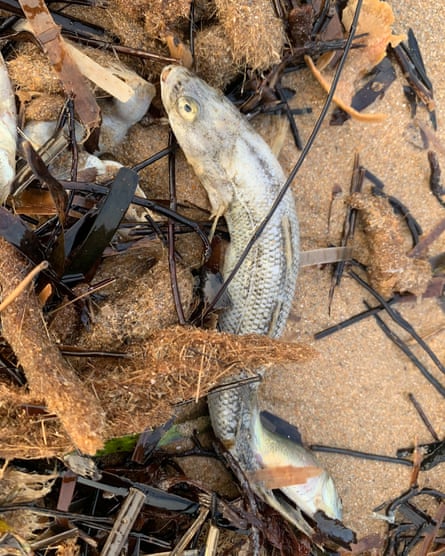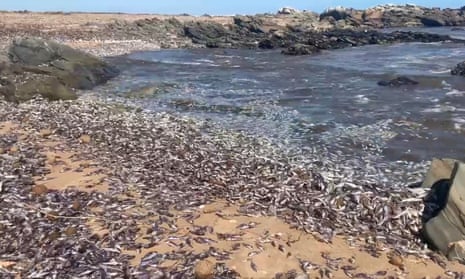Waters from last year’s floods in Australia’s south-east are gushing out to sea and taking carp with them – but the salinity of the ocean is killing the invasive species, so dead fish are now washing up on South Australian beaches.
Pictures from Middleton, Port Elliot and Goolwa show piles of juvenile carp littering the shores of the popular summer destinations.
The principal biosecurity officer for weeds and pests at the state’s Department of Primary Industries and Regions, said it was normal for carp to spawn at this time of year, but that the high flows were flushing them from the fresh water of the River Murray into the marine environment.
“They’re normally tolerant [of different environments] but don’t take high salinity well … that’s why we’re seeing fish deaths,” she said.
“Normally when there’s a fish kill event, the fish will be either consumed by other species or degrade and form part of the natural system.
“We do still expect them to be washed back in over days and weeks.”
Sign up for Guardian Australia’s free morning and afternoon email newsletters for your daily news roundup
If the piles of rotting fish do accumulate, though, she said there is a plan to bring in contractors to remove them in a sustainable way, possibly through composting.
On Facebook, John Cork-Gorringe wrote there were mulloway and bream at Middleton as well.

“The shallows are alive with carp struggling in the salty water,” he wrote. “I will never see this again in my lifetime.”
Rodgers said the dead fish were mostly carp, which have invaded Australia’s rivers in enormous numbers.
In 2016, the then water minister, Barnaby Joyce, announced a plan to introduce the herpes virus into the carp population to control their numbers.
But the National Carp Control Plan (NCCP) was released at the end of the year, it recommended more research be done.
Carp have since been spawning in huge numbers, particularly after the floods.
A group of Charles Sturt University ecologists this week said the “videos of writhing masses of both adult and young fish illustrate that all is not well in our rivers”.
after newsletter promotion
They described the “house of horrors” the carp cause as they degrade plants and habitats. “They can make the bed of many rivers look like the surface of golf balls – denuded and dimpled, devoid of any habitat,” they said in the Conversation.
They said the previous estimate of up to 357 million fish in Australia’s rivers and wetlands could be exceeded this year.
“Carp are super-abundant right now because floods give them access to floodplain habitats,” the ecologists said.
“There, each large female can spawn millions of eggs and the young have high survival rates.”
It’s a boom year because of the flooding and the spike in numbers has prompted calls for a release of the herpes virus.
We need to have a “serious conversation” about the virus, the experts said, as well as other methods such as manipulating water levels to help native fish and disrupt conditions for carp to breed – but there are “no silver bullets”.
“While numbers will decline as the floods subside, the number of juveniles presently entering back into rivers will be stupendous and may last years,” they said.
The federal Department of Agriculture, Fisheries and Forestry said in a statement that the federal government was working with states and territories to agree on the next steps of the NCCP.
“Although the NCCP report provides insights into the feasibility of the carp virus as a biocontrol agent, there remain uncertainties regarding the efficiency and effectiveness of the virus in safely removing carp from Australian waterways,” it said, adding it would take several years to complete further research and to reach agreement from all jurisdictions on the plan.
